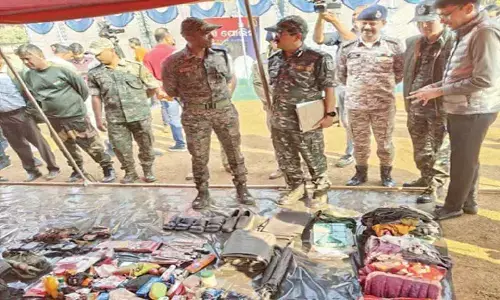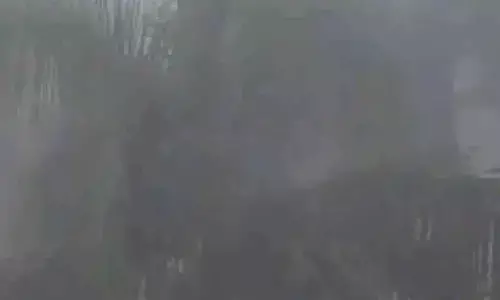Tracing History: Chin Qalich Khan, the forgotten Mughal commander

Tracing History: Chin Qalich Khan, the forgotten Mughal commander
The tomb of Mughal commander, who stormed Golconda Fort and helped Emperor Aurangzeb to unfurl his flag in Deccan, lies in utter neglect
'Do you know where this place is?' I asked a man selling ice cream in Kismatpur, showing him a picture on my phone. The efforts were in vain, for hardly anybody knew where it was. Not losing hope, I kept going and approached a structure resembling an old mosque.
I thought that could be the one, but not anymore after I saw a group of teenagers and kids playing ball in a vast field next to it. 'This can't be that one' I told myself, knowing how the Islamic rulers were laid to rest.
But I didn't know under what category to place the man whose tomb I was searching for. Was he to be called a Mughal or the man who technically laid the foundation, as HG Briggs called it, to 'the Greatest Mohammadan power in India.'
'Chin Qalich Khan Khwaja Abid Siddiqui', not many have heard his name. Neither did I, until I attended my first heritage walk by Yunus Lasania at Qutb Shahi tombs, nearly a year ago. He's barely remembered by Hyderabadis today, and to the handful who thankfully do, as a man with two graves.
In the midnight hour of 21st September 1687, Mughal general Ruhullah Khan secretly made negotiations with Abdullah Khan Panni, an Afghan soldier in the Golconda Army. Thanks to bribery, the latter opened one of the minor gates near Fateh Darwaza, through which the Mughal army made its way into the inner fort, after nearly 8 months of failed attempts to break the walls down.
But days before this bribery, Mughal Commander Chin Qalich Khan was approaching the fort for an attack, when a cannonball tore away his right arm from the shoulder. He was immediately taken to a medical camp where he was treated by the royal surgeons.
Though they assured Aurangzeb that Chin Qalich Khan would recover soon, they couldn't save him after which he was buried on the banks of what we know today as the Himayat Sagar Lake. Few days later, his right arm was identified by a signet ring that he wore, which was given a separate burial, yards away from where he was laid to rest.
Though Aurangzeb had quenched his thirst of a lifetime to unfurl the Mughal flag over Golconda, he did have to pay a huge price that was losing some of his best generals, including Khwaja Abid. I believe, as an act of remorse for the loss, he personally trained Khwaja Abid's grandson, Mir Qamruddin.
As John Zubrzycki writes, when the young boy was brought to Aurangzeb's court by his father Ghaziuddin Khan, he received him with kindness and told his father "The star of destiny shines on the forehead of your son." There was no surprise that Aurangzeb's blessings were indeed powerful for Mir Qamruddin went on to be known as Nizam ul Mulk, establishing the Asaf Jahi dynasty in 1724 and becoming the first ever Nizam of Hyderabad.
With the help of my intuition, I stopped at a Dargah next to the ORR highway but I was skeptical if his tomb could actually be that simple. 'Qalich Khan Dargah' I asked the local priests and was immediately guided to a small, open area surrounded by walls on all the sides.
And inside it was the tomb of Khwaja Abid, covered in a traditional green cloth, with two smaller tombs on either side. Unornamented unlike his predecessors and successors, the frontal portion of his tomb contained a white marble plate, with words inscribed in Persian. When I entered that complex, it all felt so surreal that it took me some time to comprehend where I really was.
I went to his tomb and bent down on my knees, only to become numb by the fact coupled with the emotions that I was just a few feet away from where the mortal remains of a man with such a legacy were buried. I went around the whole place, which even housed numerous other smaller tombs of unknown people.
But what really hit me was the fact that it was the same place which I had earlier visited - the field where young boys were playing, just that I had now arrived from another side. The boys were so carefree and at such an ease that little realised that their playground housed the man whose heirs changed Hyderabad's history forever.
It was heart wrenching to know that even the priests at the Dargah didn't know where Chin Qalich Khan's hand was buried. They in return were so intrigued when I told them about the Golconda siege of 1687 and his story.
The sun was going down, just like how it did on the ruins of Golconda 333 years ago, and it was time for me to leave. But for some reason, I was unwilling to do so. There was an unexplainable tranquility in that place, which made me want to stay there for longer and just stare with awe at his tomb, swelling my heart with pride of my city's extraordinary history.
On my way back home, it made me question - What does it feel like to have, in a way, started one of the greatest and richest dynasties of all time, and been the man who was ever so respected and loved by rulers like Aurangazeb and yet be left like an orphan in a remote village, isolated from the rest of the world and allowing the superpowers of nature and time to hide your contribution to Medieval India and the Deccan? After all, for all of us are just visitors to this mysterious planet, what we do during our limited time here is remembered. Once we're gone, we're gone forever.




















